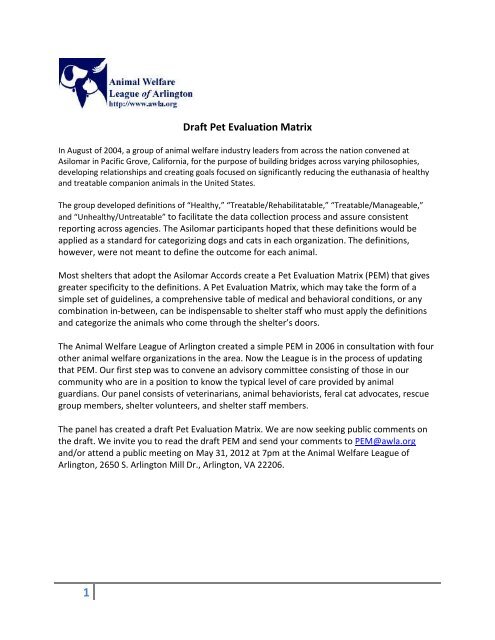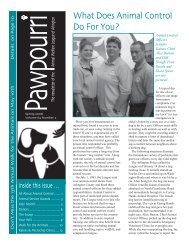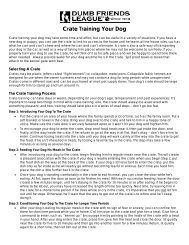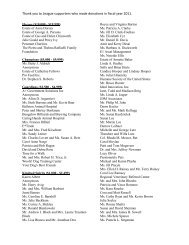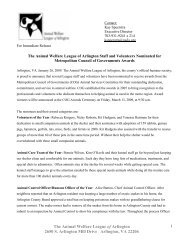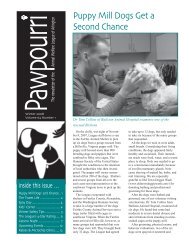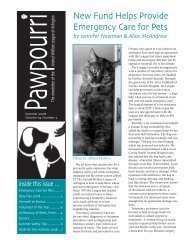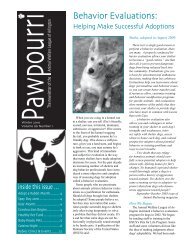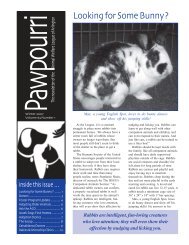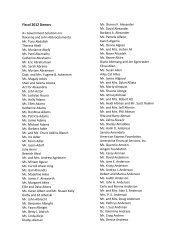Draft Pet Evaluation Matrix - Animal Welfare League of Arlington
Draft Pet Evaluation Matrix - Animal Welfare League of Arlington
Draft Pet Evaluation Matrix - Animal Welfare League of Arlington
You also want an ePaper? Increase the reach of your titles
YUMPU automatically turns print PDFs into web optimized ePapers that Google loves.
<strong>Draft</strong> <strong>Pet</strong> <strong>Evaluation</strong> <strong>Matrix</strong><br />
In August <strong>of</strong> 2004, a group <strong>of</strong> animal welfare industry leaders from across the nation convened at<br />
Asilomar in Pacific Grove, California, for the purpose <strong>of</strong> building bridges across varying philosophies,<br />
developing relationships and creating goals focused on significantly reducing the euthanasia <strong>of</strong> healthy<br />
and treatable companion animals in the United States.initions: To<br />
The group developed definitions <strong>of</strong> “Healthy,” “Treatable/Rehabilitatable,” “Treatable/Manageable,”<br />
and “Unhealthy/Untreatable” to facilitate the data collection process and assure consistent<br />
reporting across agencies. The Asilomar participants hoped that these definitions would be<br />
applied as a standard for categorizing dogs and cats in each organization. The definitions,<br />
however, were not meant to define the outcome for each animal.<br />
Most shelters that adopt the Asilomar Accords create a <strong>Pet</strong> <strong>Evaluation</strong> <strong>Matrix</strong> (PEM) that gives<br />
greater specificity to the definitions. A <strong>Pet</strong> <strong>Evaluation</strong> <strong>Matrix</strong>, which may take the form <strong>of</strong> a<br />
simple set <strong>of</strong> guidelines, a comprehensive table <strong>of</strong> medical and behavioral conditions, or any<br />
combination in-between, can be indispensable to shelter staff who must apply the definitions<br />
and categorize the animals who come through the shelter’s doors.<br />
The <strong>Animal</strong> <strong>Welfare</strong> <strong>League</strong> <strong>of</strong> <strong>Arlington</strong> created a simple PEM in 2006 in consultation with four<br />
other animal welfare organizations in the area. Now the <strong>League</strong> is in the process <strong>of</strong> updating<br />
that PEM. Our first step was to convene an advisory committee consisting <strong>of</strong> those in our<br />
community who are in a position to know the typical level <strong>of</strong> care provided by animal<br />
guardians. Our panel consists <strong>of</strong> veterinarians, animal behaviorists, feral cat advocates, rescue<br />
group members, shelter volunteers, and shelter staff members.<br />
The panel has created a draft <strong>Pet</strong> <strong>Evaluation</strong> <strong>Matrix</strong>. We are now seeking public comments on<br />
the draft. We invite you to read the draft PEM and send your comments to PEM@awla.org<br />
and/or attend a public meeting on May 31, 2012 at 7pm at the <strong>Animal</strong> <strong>Welfare</strong> <strong>League</strong> <strong>of</strong><br />
<strong>Arlington</strong>, 2650 S. <strong>Arlington</strong> Mill Dr., <strong>Arlington</strong>, VA 22206.<br />
1
AWLA <strong>Draft</strong> <strong>Pet</strong> <strong>Evaluation</strong> <strong>Matrix</strong><br />
The following definitions and the categories <strong>of</strong> conditions within these definitions do not define<br />
the outcome for each animal.<br />
Healthy: The term "healthy" means and includes all dogs and cats eight weeks <strong>of</strong> age or older<br />
that, at or subsequent to the time the animal is taken into possession, have manifested no sign<br />
<strong>of</strong> a behavioral or temperamental characteristic that could pose a health or safety risk or<br />
otherwise make the animal unsuitable for placement as a pet, and have manifested no sign <strong>of</strong><br />
disease, injury, a congenital or hereditary condition that adversely affects the health <strong>of</strong> the<br />
animal or that is likely to adversely affect the animal's health in the future.<br />
Treatable Rehabilitatable<br />
Treatable: The term "treatable" means and includes all dogs and cats who are "rehabilitatable"<br />
and all dogs and cats who are "manageable."<br />
Medical<br />
Rehabilitatable: The term "rehabilitatable" means and includes all dogs and cats who<br />
are not "healthy," but who are likely to become "healthy," if given medical, foster,<br />
behavioral, or other care equivalent to the care typically provided to pets by<br />
reasonable and caring pet owners/guardians in the community.<br />
Ear infection, non surgical<br />
Kennel cough<br />
Fatty tumors<br />
Cystitis<br />
Pneumonia<br />
Sarcoptic mange<br />
Minor/closed wound broken bone(s)<br />
Heartworm stage 1 and 2<br />
Demodectic mange<br />
Cherry eye<br />
Conjunctivitis<br />
Intestinal parasites<br />
Ear mites<br />
Coccidiosis<br />
Upper respiratory infection<br />
Pyometra<br />
Ringworm<br />
Parvo<br />
Open wound/compound/severe broken bones<br />
Unweaned infants without nursing mother<br />
Hepatic lipidosis (fatty liver disease)<br />
Malnourishment<br />
2
Treatable/Manageable<br />
Manageable: The term "manageable" means and includes all dogs and cats who are not<br />
"healthy" and who are not likely to become "healthy," regardless <strong>of</strong> the care provided; but<br />
who would likely maintain a satisfactory quality <strong>of</strong> life, if given medical, foster, behavioral, or<br />
other care, including long-term care, equivalent to the care typically provided to pets by<br />
reasonable and caring owners/guardians in the community; provided, however, that the term<br />
"manageable" does not include any dog or cat who is determined to pose a significant risk to<br />
human health or safety or to the health or safety <strong>of</strong> other animals.<br />
Medical<br />
Chronic ear infection (non surgical)<br />
Bladder stones<br />
Mild dysplasia<br />
Non severe arthritis<br />
Cushings disease<br />
Spinal cord injury<br />
Hyperthyroidism<br />
Congestive heart failure<br />
Heart murmurs<br />
Allergies<br />
Controlled seizures<br />
Controlled diabetes<br />
Hip dysplasia with osteoarthritis<br />
Cancer<br />
Life threatening wound/injury<br />
Feline Immunodeficiency Virus +/exposed<br />
Kidney failure<br />
Liver failure<br />
Treatable/Manageable—Behavioral<br />
Mild to moderate shy dogs/cats with no<br />
concern regarding aggression<br />
Dogs/cats with minor/moderate handling<br />
problems<br />
Dogs with mild/moderate separation anxiety<br />
Resource guarders that do not pose a significant<br />
risk to the safety <strong>of</strong> humans or other animals<br />
Serious dog to dog aggressive behavior<br />
Serious cat to cat aggressive behavior<br />
3
Unhealthy/Untreatable<br />
Unhealthy and Untreatable: The term "unhealthy and untreatable" means and includes all<br />
dogs and cats who, at or subsequent to the time they are taken into possession,<br />
1) Have a behavioral or temperamental characteristic that poses a health or safety<br />
risk or otherwise makes the animal unsuitable for placement as a pet, and are not<br />
likely to become "healthy" or "treatable" even if provided the care typically provided<br />
to pets by reasonable and caring pet owners/guardians in the community; or<br />
2) Are suffering from a disease, injury, or congenital or hereditary condition that<br />
adversely affects the animal's health or is likely to adversely affect the animal's health<br />
in the future, and are not likely to become "healthy" or "treatable" even if provided<br />
the care typically provided to pets by reasonable and caring pet owners/guardians in<br />
the community; or<br />
3) Are under the age <strong>of</strong> eight weeks and are not likely to become "healthy" or<br />
"treatable," even if provided the care typically provided to pets by reasonable and<br />
caring pet owners/guardians in the community.<br />
Medical<br />
Heartworm stage 3<br />
Urethral block in cats<br />
Any infectious disease not responding to<br />
treatment<br />
Feline Infectious Peritonitis suspect or exposed<br />
Feline Leukemia Virus + or exposed<br />
Panleukopenia<br />
Uncontrolled diabetes<br />
Uncontrolled seizures<br />
Chronic demodex mange not responding to<br />
treatment<br />
Rabies exposure<br />
Acute or end stage kidney or liver failure<br />
Distemper<br />
Parvo + (if moribund)<br />
Malignant, untreatable tumors<br />
Unhealthy/Untreatable -- Behavioral<br />
Habitual house soiling not responsive to<br />
behavior modification<br />
Serious anxiety including self-destructive<br />
behavior<br />
Serious stranger/barrier issues<br />
Very shy cats/dogs with concern regarding<br />
aggression<br />
History <strong>of</strong> serious injury to people or other<br />
companion animals<br />
High likelihood <strong>of</strong> causing serious injury to a<br />
person<br />
Feral cats/dogs<br />
4


